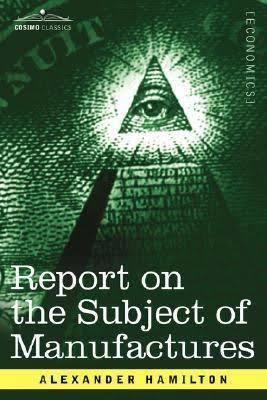 | ||
Similar Works by Alexander Hamilton, Economic history books | ||
Report on manufactures
The Report on the Subject of Manufactures, generally referred to by its shortened title Report on Manufactures, is the third report, and magnum opus, of American Founding Father and 1st U.S. Treasury Secretary Alexander Hamilton. It was presented to Congress on December 5, 1791
Contents
- Report on manufactures
- Economic plan
- The tariff
- Subsidies to industry
- Adoption by Congress
- Opposition to the Report
- References
It laid forth economic principles rooted in both the Mercantilist System of Elizabeth I's England and the practices of Jean-Baptiste Colbert of France. The principal ideas of the Report would later be incorporated into the "American System" program by Senator Henry Clay of Kentucky and his Whig Party. Abraham Lincoln, who called himself a "Henry Clay tariff Whig" during his early years, would later make the principles cornerstones, together with opposition to the institution and expansion of slavery, of the fledgling Republican Party.
Hamilton's ideas formed the basis for the American School of economics.
Economic plan
Hamilton reasoned that to secure American independence, the United States needed to have a sound policy of encouraging the growth of manufacturing and secure its future as a permanent feature of the economic system of the nation. He argued these could be achieved through bounties or subsidies to industry, regulation of trade with moderate tariffs (not intended to discourage imports but to raise revenue to support American manufacturing through subsidy), and other government encouragement. These policies would not only promote the growth of manufacturing but provide diversified employment opportunities and promote immigration into the young United States. They would also expand the applications of technology and science for all quarters of the economy, including agriculture.
The tariff
Hamilton reasoned that tariffs issued in moderation would raise revenue to fund the nation. The tariff could also be used to encourage domestic (or national) manufacturing and growth of the economy by applying the funds raised in part towards subsidies (called bounties in his time) to manufacturers. Hamilton sought to use the tariff to:
Subsidies to industry
Hamilton reasoned that bounties (subsidies) to industry, which would rely on funds raised by moderate tariffs, would be the best means of growing manufacturing without decreasing supply or increasing prices of goods. Such encouragement through direct support would make American enterprise competitive and independent along with the nation as a whole. In part subsidies would be used to:
Adoption by Congress
Though Congress refused to accept Hamilton's proposals in 1791, due to opposition from James Madison and his supporters, much of Hamilton's third report would later be adopted by the United States Congress despite continued opposition to the support of industry through subsidy. Both sides agreed that manufacturing independence was desirable and necessary but disagreed on how to obtain it. The Jeffersonian Democratic-Republican Party's main objection to subsidy was their fear that subsidy would lead to corruption and favoritism of certain sections of the new nation over others; namely the north over the agrarian south. This divide (north vs. south) would come up again and again in issues of economic policy until the outbreak of the American Civil War.
It is often thought that Hamilton's report was completely ignored, but in fact "Hamilton worked to ensure that Congress enacted virtually every tariff recommendation in the report within five months of its delivery." Hamilton's revenue-based trade policy, with its more moderate tariffs, meant that, by 1794, manufacturers had switched their support from the Federalists to the Republicans.
Opposition to the Report
Leading opponents of Alexander Hamilton's economic plan included Thomas Jefferson (until later years) and James Madison, who were opposed to the use of subsidy to industry along with most of their fledgling Democratic-Republican Party. Instead of bounties they reasoned in favor of high tariffs and restrictions on imports to increase manufacturing; which interestingly was favored by the manufacturers themselves who desired protection of their home market. Although the Jeffersonian stance originally favored an "agrarian" economy of farmers, this changed over time to encompass many of Hamilton's original ideas, while "the Madison administration helped give rise to the first truly protectionist tariff in U.S. history."
